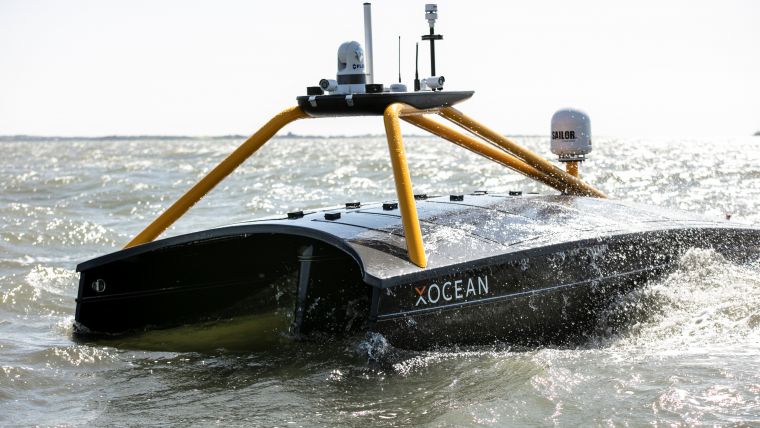“Blue technology industries will help the expansion of the hydrographic market”
A view of hydrographic technology and the market for 2020
In the last decade, there has been a steady march towards the automation of hydrographic data collection. Jim Gardiner, a research scientist at Valeport, views the technical and commercial challenges in hydrographic operations.
In terms of multibeam technology, we’ve seen continual advancements from the main players such as Teledyne Reson, Kongsberg, R2Sonic and the emergence of Norbit. Alongside this, there has been a steady improvement in GPS, inertial positioning systems and acquisition/processing software. As the capability of these systems has improved, it has placed a focus on the importance of accurate and reliable sound velocity data. To achieve accurate bathymetry, knowledge and understanding of your sound velocity environment is critical, particularly in coastal and estuarine environments.
Vendor Agnostic
All multibeam systems need sound velocity data at the transceiver, and while some have chosen a tightly coupled solution, most have opted to stay vendor agnostic. Taking regular sound velocity profiles through the water column to correct for refraction has always required considerably more effort. Valeport developed its SWiFT Sound Velocity Profiler to make this process as simple as possible for the surveyor, while maintaining the quality required to meet the highest of survey specifications. A fundamental part of the design process was to eliminate or automate any repetitive steps. GPS was integrated to automatically geo-locate and time-synchronize any data collected.
Automatic Profile Acquisition
Bluetooth LE was chosen to allow for seamless and automatic connectivity with both PC and mobile platforms. Firmware and operating modes were simplified, alongside software providing automatic profile acquisition and translation into a wide range of industry data formats. Longer endurance was allowed for with a large battery capacity and ultra-low power sleep modes.
Stopping a vessel to take a profile is both time-consuming and, in many cases, impractical. Deployment systems such as the Teledyne Oceanscience RapidCast winch allow for the automated acquisition of profiles while the vessel is underway and can be used with the SWiFT in shallow water, and the RapidPro SVT in deeper water to acquire profiles up to 500m depth while underway.
Traditional Hydrographic Surveyor
The features that have made the SWiFT popular with the traditional hydrographic surveyor have also made it popular with the new raft of autonomous survey vessel developers such as XOcean, Seafloor Systems and Unmanned Survey Solutions for integrations within unmanned survey platforms. Machine to Machine communications allow for interaction between systems without human intervention, as developers strive for the ability to survey for extended periods in hostile environments, beyond the capabilities of traditional manned systems. Profiling from an unmanned vessel presents its own set of unique challenges and Valeport has been actively working with developers to overcome these issues.
Environmental Impact
Valeport collaborated with XOCEAN’s Irish sea mission in October 2018 to deliver a step change in the cost, environmental impact and safety of collecting data, with the specifically designed XO-450 platform. Valeport’s MiniSVS and SWiFT SVP were used to enhance the resolution and accuracy of the multibeam system, which was operated from the USV in a range of weather conditions and sea states, as well as a variety of inshore and offshore locations. XOCEAN’s mission demonstrated that the platform had an endurance of up to 18 days and a range of 1,512 nautical miles, evidencing it as a flexible system capable of delivering data for a wide range of applications, and making it ideal for performing safe and cost-effective bathymetric survey work.
Accessibility, Packaging and Interfacing
I think the driving force behind our product development for the hydrographic market will not solely be in the sensor technology, which we will always continue to refine and improve, but in accessibility, packaging and interfacing – improving the way our instruments can be interacted with by both human operators and machines. The SWiFT was our first instrument with rechargeable battery technology and looking to the future, the logical next step would be wireless charging, although this is not without some technical challenges. The adoption of technology from other industries (mobile phones particularly) is a double-edged sword.
On the one hand, it allows for ready and easy integration of technology such as GPS and Bluetooth, but technology moves so quickly that parts rapidly become obsolete and further development is required to keep up to date. Inevitably, as new blue technology industries continue to evolve, these sectors will help the continued expansion of the hydrographic market and fuel future innovation.
About Valeport
Valeport is a UK-based manufacturer of oceanographic and hydrographic instrumentation. The company designs and manufactures instrumentation for the oceanographic and hydrographic communities with a worldwide customer base that includes the defence, environmental, oil and gas, renewable energy, construction and dredging sectors. It has supplied to the subsea sector since it was established in 1969. Now an independent, family-owned business, Valeport employs more than 90 people from its base in Devon (UK) and works with a global network of agents. www.valeport.co.uk.
(This article was published in Hydro International's Business Guide 2020)

Value staying current with hydrography?
Stay on the map with our expertly curated newsletters.
We provide educational insights, industry updates, and inspiring stories from the world of hydrography to help you learn, grow, and navigate your field with confidence. Don't miss out - subscribe today and ensure you're always informed, educated, and inspired by the latest in hydrographic technology and research.
Choose your newsletter(s)
























